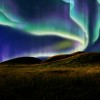What Role Magnetic Fields Play in the Creation of the Northern Lights
You may have never seen the Northern Lights in person, but you've probably seen photos or videos of this natural light show in the night sky. If you're like us, seeing this phenomenon might leave you wondering why the skies light up around the Earth's poles. Simply, magnetic fields play in the creation — read on for the explanation and answers to other questions regarding the Northern Lights.
What are the Northern Lights?
If you're unfamiliar with the Northern Lights, they look as though multiple colorful spotlights are being moved across the night sky. They can appear in a variety of colors, such as green, blue, violet, red and yellow, and take different shapes and formations as they dance overhead.
Although people tend to refer to this phenomenon as the Northern Lights they also have two other names, depending on where you are in the world. In northern latitudes, they are called the aurora borealis, whereas in southern latitudes, the Northern Lights are called the aurora australis.
Why do the Northern Lights occur?
So how are natural light shows possible, and why do they tend to show up close to the Earth's poles? The answer isn't rare Earth magnets, but it actually has a lot to do with magnetic fields. The origin of each shred of light actually begins far from Earth though- 92,960,000 miles away, to be precise.
The Library of Congress states that it all begins with activity on the surface of the sun. Although scientists refer to what happens as a "coronal mass ejection," the sun essentially ejects a cloud of gas that travels through space. Should the gas make it far enough to Earth, it collides with the planet's protective magnetic field.
This impact creates a reaction within the magnetic field, which leads to the creation of charged particles that are pushed toward the Earth's polar regions by magnetic force. When they arrive at the poles, they come into contact with oxygen and nitrogen atoms and are enhanced by energy present in the upper atmosphere. The end result is an awe-inspiring light show.
What color the light ends up depending on the types of atoms they encounter. According to Canada's Northern Lights Centre, oxygen molecules help produce a pale yellowish-green color, which is also the most common form of aurora. All red lights are created by oxygen at high altitudes, but these are considered to be quite rare. Nitrogen molecules help produce blue or purplish-red aurora.
Where should you go to see the Northern Lights?
While they are usually associated with the Earth's poles, the Northern Lights can actually be seen anywhere in the world. For instance, the Northern Lights Centre says they have been spotted in spots like New Orleans, La., while The Library of Congress lists Mexico as another location where the phenomenon has been seen.
However, if you don't want to be disappointed, you should set out in search of the Northern Lights in the northern hemisphere, naturally. If you're in Europe, Fodor's recommends you visit Denmark, Finland, Iceland, Norway, Russia, Scotland or Sweden. In North America, Alaska, Canada and Greenland are the places to be to check out the aurora. Keep in mind that you'll be able to see the Northern Lights a lot better if you're in an area that is low on "light pollution." So if you don't want to miss them, think rural, rather than bustling urban areas. Once you know where to look, it's all about gazing up at the stars and enjoying nature's answer to a laser show.
Read More Magnetic Discoveries with Apex!
Since writing this blog, there have been new discoveries on the cause of auroras! Read all about it in this blog post here. Want to have these exciting discoveries and more sent right to your inbox each month? Subscribe to our newsletter – there are even special discounts for our subscribers.

